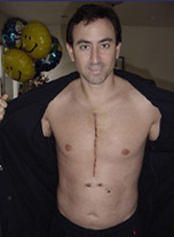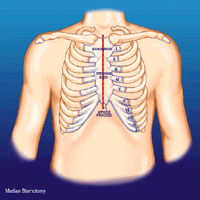Breaking The Sternum During Heart Surgery Using A Median Sternotomy
As I personally experienced, a median sternotomy is a type of surgical procedure in which a vertical inline incision is made along the sternum, after which the sternum itself is divided, or “cracked”.
For the surgeon, breaking the sternum provides access to the heart and the lungs for surgical procedures such as heart transplants, coronary artery bypass grafts, atrial fibrillation, heart valve repair and heart valve replacement operations.
 Adam's Sternum Incision (One-Week Post-Op)
Adam's Sternum Incision (One-Week Post-Op)
Interestingly, the term median sternotomy often mistakenly implies an "open heart surgery". Open heart surgery involves the incision of the pericadium and many median sternotomy procedures do not require this. At the same time, there are many different surgical approach for open heart surgery that use minimally-invasive techniques (e.g. mini-sternotomy and mini-thoracotomy) not median sternotomies.
In the case of a surgical heart valve surgery that uses a median sternotomy, the pericardium is pierced and the procedure is appropriately referred to as an “open heart” operation. Open heart surgery typically involves the use of a cardiac pump, also known as a heart-lung machine, while the patient's heart is stopped and cooled.

Once the defective heart valve is either repaired or replaced, the heart is restarted.
Like any other broken bone, the sternum requires time to heal. While each patient heals at their own rate, many cardiothoracic surgeons typically estimate that a broken sternum will heal in a six-to-nine week timeframe. Please remember, that healing is a personal and unique process for each patient.
Infections & Complications of Median Sternotomy
Infection resulting from wound complications has been sited as a small issue with the median sternotomy procedure. According to the NCBI, in a study of 9,279 sternotomies performed during a period of 2½ years, only 61 (0.66%) patients developed significant wound complications.
Of these, 58 (95.1%) survived. Sternal infection occurred in 36 patients (0.39%). Predisposing factors included chronic obstructive pulmonary disease, diabetes mellitus, obesity, closed chest massage, prolonged assisted ventilation, and excessive bleeding after operation.
To learn more about sternum healing and infections related to heart surgery, I recently interviewed Dr. Steven Bolling, the Director of the Mitral Valve Program, at Michigan Medicine in Ann Arbor, Michigan. Here the highlights of that interview.
As Dr. Bolling alludes... After the sternum is broken it should take about about four weeks for the bone to heal. In addition, his ideas about sternal infection are encouraging and support the NCBI data above.
It should also be noted that rigid sternal fixation is a newer technology which has been shown to enhance broken sternum recovery rates in heart surgery patients when compared to traditional sternum wires. To learn more about rigid sternal fixation, click here.
You Might Also Like
To help you learn more, here's additional information about heart valve surgery:
- Open Heart Surgery Scars: 3 Different Types
- Rigid Sternal Fixation: 6 Important Facts
- Heart Surgery Recovery Time
- Heart-Lung Machine: Top 5 Facts
- Discover the Heart Valve Learning Center
- Meet Heart Valve Patients in Our Community!
Page last updated: September 18, 2020




